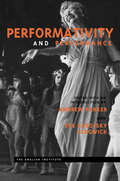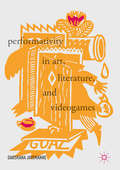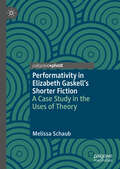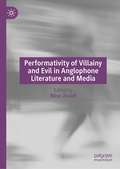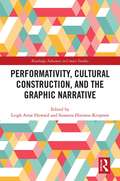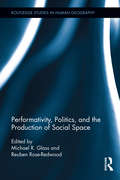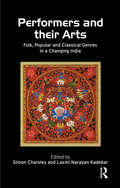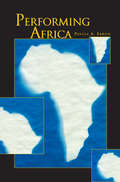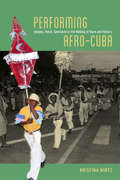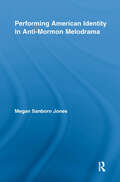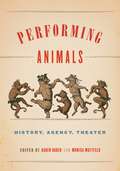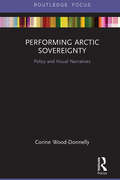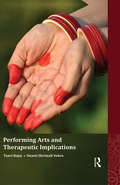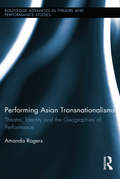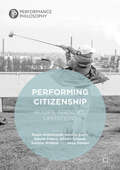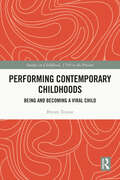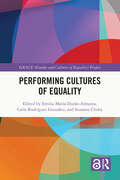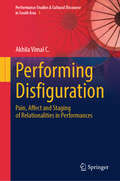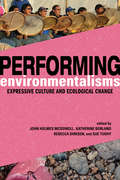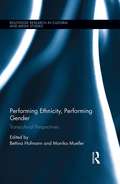- Table View
- List View
Performativity and Performance (Essays from the English Institute)
by Andrew Parker Eve Kosofsky SedgwickFrom the age of Aristotle to the age of AIDS, writers, thinkers, performers and activists have wresteled with what "performance" is all about. At the same moment, "performativity"--a new concept in language theory--has become a ubiquitous term in literary studies. This volume grapples with the nature of these two key terms whose traces can be found everywhere: in the theatre, in the streets, in philosophy, in questions of race and gender, and in the sentences we speak.
Performativity in Art, Literature, and Videogames
by Darshana JayemanneThis book modifies the concept of performativity with media theory in order to build a rigorous method for analyzing videogame performances. Beginning with an interdisciplinary exploration of performative motifs in Western art and literary history, the book shows the importance of framing devices in orienting audiences' experience of art. The frame, as a site of paradox, links the book's discussion of theory with close readings of texts, which include artworks, books and videogames. The resulting method is interdisciplinary in scope and will be of use to researchers interested in the performative aspects of gaming, art, digital storytelling and nonlinear narrative.
Performativity in Elizabeth Gaskell’s Shorter Fiction: A Case Study in the Uses of Theory
by Melissa SchaubThis book simultaneously examines the specific theoretical issues raised by Elizabeth Gaskell’s use of characterization in her shorter fiction, and addresses the larger question of how literary critics ought to use theory. The text gives a history of Judith Butler’s theory of performativity and the uptake of that theory in literary criticism, and also provides detailed close reading of Gaskell’s fiction—both frequently examined texts like Cranford, Mary Barton, and Wives and Daughters, and some that are less often studied, such as “Lizzie Leigh” and Cousin Phillis. The book argues that as theory becomes naturalized into the vocabulary of literary scholars, it often becomes more optimistic and less specific. In discussing the naturalization of theory exemplified by the application of performativity to Gaskell, the book advances general principles on the use of theory. It can be read as scholarship or used as a textbook in literary methods courses.
Performativity of Villainy and Evil in Anglophone Literature and Media
by Nizar ZouidiPerformativity of Villainy and Evil in Anglophone Literature and Media studies the performative nature of evil characters, acts and emotions across intersecting genres, disciplines and historical eras. This collection brings together scholars and artists with different institutional standings, cultural backgrounds and (inter)disciplinary interests with the aim of energizing the ongoing discussion of the generic and thematic issues related to the representation of villainy and evil in literature and media. The volume covers medieval literature to contemporary literature and also examines important aspects of evil in literature such as social and political identity, the gothic and systemic evil practices. In addition to literature, the book considers examples of villainy in film, TV and media, revealing that performance, performative control and maneuverability are the common characteristics of villains across the different literary and filmic genres and eras studied in the volume.
Performativity, Cultural Construction, and the Graphic Novel (Routledge Advances in Comics Studies)
by Leigh Anne Howard Susanna Hoeness-KrupsawPerformance, Social Construction and the Graphic Narrative draws on performance studies scholarship to understand the social impact of graphic novels and their sociopolitical function. Addressing issues of race, gender, ethnicity, race, war, mental illness, and the environment, the volume encompasses the diversity and variety inherent in the graphic narrative medium. Informed by the scholarship of Dwight Conquergood and his model for performance praxis, this collection of essays makes links between these seemingly disparate areas of study to open new avenues of research for comics and graphic narratives. An international team of authors offer a detailed analysis of new and classical graphic texts from Mexico, India, and Canada as well as the US. Performance, Social Construction and the Graphic Narrative draws on performance studies scholarship to understand the social impact of graphic novels and their sociopolitical function. Addressing issues of race, gender, ethnicity, race, war, mental illness, and the environment, the volume encompasses the diversity and variety inherent in the graphic narrative medium. This book will be of interest to students and scholars in the areas of communication, literature, comics studies, performance studies, sociology, languages, English, and gender studies, and anyone with an interest in deepening their acquaintance with and understanding of the potential of graphic narratives.
Performativity, Politics, and the Production of Social Space: Performativity, Politics, And The Production Of Social Space (Routledge Studies in Human Geography #51)
by Michael R. Glass Reuben Rose-RedwoodTheories of performativity have garnered considerable attention within the social sciences and humanities over the past two decades. At the same time, there has also been a growing recognition that the social production of space is fundamental to assertions of political authority and the practices of everyday life. However, comparatively little scholarship has explored the full implications that arise from the confluence of these two streams of social and political thought. This is the first book-length, edited collection devoted explicitly to showcasing geographical scholarship on the spatial politics of performativity. It offers a timely intervention within the field of critical human geography by exploring the performativity of political spaces and the spatiality of performative politics. Through a series of geographical case studies, the contributors to this volume consider the ways in which a performative conception of the "political" might reshape our understanding of sovereignty, political subjectification, and the production of social space. Marking the 20th anniversary of the publication of Judith Butler’s classic, Bodies That Matter (1993), this edited volume brings together a range of contemporary geographical works that draw exciting new connections between performativity, space, and politics.
Performers and Their Arts: Folk, Popular and Classical Genres in a Changing India
by Simon CharsleyIntroduction Part I: Caste, Community and performance A ritual performance of Kerala, Vayala Vasudevan PillaiThe Patuas of Bengal, Makbul IslamBards and goddesses: The Pombalas in Tirupati, Anand AkundyExplorations in the art forms of the Cindu madigas in Andhra, Y A Sudhakar Reddy and R R HarischandraCaste identity and performance in a fisher-village of Assam, Kishore BhattacharjeePart II: Performance Beyond CasteTelugu pady natakam in Andhra: Performance dynamics, P SubbacharyModernising tradition: The yaksagana in Karnataka, Guru Rao BapatKalarippayatt as aesthetics and the politics of invisibility in Kerala, P K SasidharanIndia People’s Theatre Association in colonial Andhra, V RamakrishnaGaddar and the politics and pain of singing, D Venkat RaoReviving moghal tamsa in Orissa, Sachi MohantyPart III: Classical Dance and its SuccessorsNew directions in Indian dance, Sunil KothariTranspositions in kuchipudi dance, Aruna BhikshuThe impact of commercialization in dance, K Subadra MurthyArt addressing social problems, Ananda Shankar Jayant
Performers’ Rights in Sri Lanka: Singers’ Melancholia
by Gowri NanayakkaraThis book explores whether global music copyright law and the performers’ rights regime (PRR) have been able to improve the economic position of artists, as they were originally intended to. The author investigates whether this regime effectively addresses contemporary issues regarding royalty payments and cover songs in Sri Lankan music, drawing on the empirical findings of a case study she conducted on the Sinhala music industry. She finds that the PRR developed internationally and implemented in Sri Lanka is predicated on a particular view of the role of performers and their relationships with other actors in the music industry; although this view can be found in the USA, UK and India, it does not seem to reflect the established practices and relationships within Sri Lanka’s contemporary music industry. While providing a socio-historical and legal analysis of these differing industrial settings and investigating the manner in which they impact the PRR’s (in)ability to deliver improved economic security for Sinhala singers, the book also offers policymakers recommendations on how to supplement current national copyright law and the PRR in order to provide a secure economic position for music artists in Sri Lanka.
Performing Africa
by Paulla A. EbronThe jali--a member of a hereditary group of Mandinka professional performers--is a charismatic but contradictory figure. He is at once the repository of his people's history, the voice of contemporary political authority, the inspiration for African American dreams of an African homeland, and the chief entertainment for the burgeoning transnational tourist industry. Numerous journalists, scholars, politicians, and culture aficionados have tried to pin him down. This book shows how the jali's talents at performance make him a genius at representation--the ideal figure to tell us about the "Africa" that the world imagines, which is always a thing of illusion, magic, and contradiction. Africa often enters the global imagination through news accounts of ethnic war, famine, and despotic political regimes. Those interested in countering such dystopic images--be they cultural nationalists in the African diaspora or connoisseurs of "global culture"--often found their representations of an emancipatory Africa on an enthusiasm for West African popular culture and performance arts. Based on extensive field research in The Gambia and focusing on the figure of the jali, Performing Africa interrogates these representations together with their cultural and political implications. It explores how Africa is produced, circulated, and consumed through performance and how encounters through performance create the place of Africa in the world. Innovative and discerning, Performing Africa is a provocative contribution to debates over cultural nationalism and the construction of identity and history in Africa and elsewhere.
Performing Afro-Cuba: Image, Voice, Spectacle in the Making of Race and History
by Kristina WirtzVisitors to Cuba will notice that Afro-Cuban figures and references are everywhere: in popular music and folklore shows, paintings and dolls of Santería saints in airport shops, and even restaurants with plantation themes. In Performing Afro-Cuba, Kristina Wirtz examines how the animation of Cuba’s colonial past and African heritage through such figures and performances not only reflects but also shapes the Cuban experience of Blackness. She also investigates how this process operates at different spatial and temporal scales#151;from the immediate present to the imagined past, from the barrio to the socialist state. Wirtz analyzes a variety of performances and the ways they construct Cuban racial and historical imaginations. She offers a sophisticated view of performance as enacting diverse revolutionary ideals, religious notions, and racial identity politics, and she outlines how these concepts play out in the ongoing institutionalization of folklore as an official, even state-sponsored, category. Employing Bakhtin’s concept of #147;chronotopes”#151;the semiotic construction of space-time#151;she examines the roles of voice, temporality, embodiment, imagery, and memory in the racializing process. The result is a deftly balanced study that marries racial studies, performance studies, anthropology, and semiotics to explore the nature of race as a cultural sign, one that is always in process, always shifting.
Performing American Identity in Anti-Mormon Melodrama (Studies in American Popular History and Culture)
by Megan Sanborn JonesIn the late nineteenth century, melodramas were spectacular entertainment for Americans. They were also a key forum in which elements of American culture were represented, contested, and inverted. This book focuses specifically on the construction of the Mormon villain as rapist, murderer, and Turk in anti-Mormon melodramas. These melodramas illustrated a particularly religious world-view that dominated American life and promoted the sexually conservative ideals of the cult of true womanhood. They also examined the limits of honorable violence, and suggested the whiteness of national ethnicity. In investigating the relationship between theatre, popular literature, political rhetoric, and religious fervor, Megan Sanborn Jones reveals how anti-Mormon melodramas created a space for audiences to imagine a unified American identity.
Performing Animals: History, Agency, Theater (Animalibus)
by Karen Raber Monica MattfeldFrom bears on the Renaissance stage to the equine pageantry of the nineteenth-century hunt, animals have been used in human-orchestrated entertainments throughout history. The essays in this volume present an array of case studies that inspire new ways of interpreting animal performance and the role of animal agency in the performing relationship.In exploring the human-animal relationship from the early modern period to the nineteenth century, Performing Animals questions what it means for an animal to “perform,” examines how conceptions of this relationship have evolved over time, and explores whether and how human understanding of performance is changed by an animal’s presence. The contributors discuss the role of animals in venues as varied as medieval plays, natural histories, dissections, and banquets, and they raise provocative questions about animals’ agency. In so doing, they demonstrate the innovative potential of thinking beyond the boundaries of the present in order to dismantle the barriers that have traditionally divided human from animal.From fleas to warhorses to animals that “perform” even after death, this delightfully varied volume brings together examples of animals made to “act” in ways that challenge obvious notions of performance. The result is an eye-opening exploration of human-animal relationships and identity that will appeal greatly to scholars and students of animal studies, performance studies, and posthuman studies.In addition to the editors, the contributors are Todd Andrew Borlik, Pia F. Cuneo, Kim Marra, Richard Nash, Sarah E. Parker, Rob Wakeman, Kari Weil, and Jessica Wolfe.
Performing Animals: History, Agency, Theater (Animalibus: Of Animals and Cultures #11)
by Karen Raber Monica MattfeldFrom bears on the Renaissance stage to the equine pageantry of the nineteenth-century hunt, animals have been used in human-orchestrated entertainments throughout history. The essays in this volume present an array of case studies that inspire new ways of interpreting animal performance and the role of animal agency in the performing relationship.In exploring the human-animal relationship from the early modern period to the nineteenth century, Performing Animals questions what it means for an animal to “perform,” examines how conceptions or this relationship have evolved over time, and explores whether and how human understanding of performance is changed by an animal’s presence. The contributors discuss the role of animals in venues as varied as medieval plays, natural histories, dissections, and banquets, and they raise provocative questions about animals’ agency. In so doing, they demonstrate the innovative potential of thinking beyond the boundaries of the present in order to dismantle the barriers that have traditionally divided human from animal.From fleas to warhorses to animals that “perform” even after death, this delightfully varied volume brings together examples of animals made to “act” in ways that challenge obvious notions of performance. The result is an eye-opening exploration of human-animal relationships and identity that will appeal greatly to scholars and students of animal studies, performance studies, and posthuman studies.In addition to the editors, the contributors are Todd Andrew Borlik, Pia F. Cuneo, Kim Marra, Richard Nash, Sarah E. Parker, Rob Wakeman, Kari Weil, and Jessica Wolfe.
Performing Anti-Slavery
by Gay Gibson CimaIn Performing Anti-Slavery, Gay Gibson Cima reimagines the connection between the self and the other within activist performance, providing fascinating new insights into women's nineteenth-century reform efforts, revising the history of abolition, and illuminating an affective repertoire that haunts both present-day theatrical stages and anti-trafficking organizations. Cima argues that black and white American women in the nineteenth-century abolitionist movement transformed mainstream performance practices into successful activism. In family circles, literary associations, religious gatherings, and transatlantic anti-slavery societies, women debated activist performance strategies across racial and religious differences: they staged abolitionist dialogues, recited anti-slavery poems, gave speeches, shared narratives, and published essays. Drawing on liberal religious traditions as well as the Eastern notion of transmigration, Elizabeth Chandler, Sarah Forten, Maria W. Stewart, Sarah Douglass, Lucretia Mott, Ellen Craft and others forged activist pathways that reverberate to this day.
Performing Arctic Sovereignty: Policy and Visual Narratives (Routledge Research in Polar Regions)
by Corine Wood-DonnellyThe Arctic is 5.5 million square miles and has been inhabited by humans for thousands of years, yet it is still a frontier of development. But who owns the Arctic? This book charts the history of performances of sovereignty over the Arctic in the policy and visual representations of the US, Canada and Russia. Focusing on narratives of the effective occupation of territory found in postage stamps, it offers a novel analysis of Arctic sovereignty. Issues such as climate change, plastics pollution and resource development continue to impact the future of this space centred around the North Pole. Who is responsible for the region? This book examines how countries have absorbed Arctic territory into their national consciousness, examining the choice of, and use of, symbols and images in postage stamps. It looks at the story of how these countries have represented their Arctic frontiers and territorial peripheries. The book argues that the performance of policy in these regions has caused relative sovereignty to become a reality. It provides an intriguing account of how these countries have, in their distinctive ways, established, legitimised and reinforced their political authority in these regions. This book will appeal to Geographers and is recommended supplementary reading for students in political history and regional studies of the North.
Performing Arts and Therapeutic Implications
by Tanvi Bajaj Swasti Shrimali VohraPresenting an alternative perspective, this book proposes that performing arts forge an emotional bond between the performer and the audience, making the act of performance a therapeutic and restorative experience, and not merely recreational. Studying the life-experiences of six artists, and their unique engagement with three art forms — music, drama and dance — the book highlights the physical, emotional, mental, and spiritual effects of performing arts both on the performers and the audience. More importantly, it takes the current understanding of the therapeutic role of arts beyond a deficit model of health that focuses on their use in curing illnesses, disabilities and imbalances, towards a more positive growth-centric model that relates them to promoting holistic mental health, well-being and happiness. It thus bridges the gap between the theoretical understanding of creative arts therapy and the practical experience of performing arts in non-therapeutic settings. Further, it assumes increasing relevance with respect to fast-changing lifestyles to which stress and ill-health are often attributed. The book will appeal to artists, educators and researchers of performing arts, applied psychology, counselling and therapy, and cultural studies, as well as interested general readers.
Performing Asian Transnationalisms: Theatre, Identity, and the Geographies of Performance (Routledge Advances in Theatre & Performance Studies)
by Amanda RogersThis book makes a significant contribution to interdisciplinary engagements between Theatre Studies and Cultural Geography in its analysis of how theatre articulates transnational geographies of Asian culture and identity. Deploying a geographical approach to transnational culture, Rogers analyses the cross-border relationships that exist within and between Asian American, British East Asian, and South East Asian theatres, investigating the effect of transnationalism on the construction of identity, the development of creative praxis, and the reception of works in different social fields. This book therefore examines how practitioners engage with one another across borders, and details the cross-cultural performances, creative opportunities, and political alliances that result. By viewing ethnic minority theatres as part of global — rather than simply national — cultural fields, Rogers argues that transnational relationships take multiple forms and have varying impetuses that cannot always be equated to diasporic longing for a homeland or as strategically motivated for economic gain. This argument is developed through a series of chapters that examine how different transnational spatialities are produced and re-worked through the practice of theatre making, drawing upon an analysis of rehearsals, performances, festivals, and semi-structured interviews with practitioners. The book extends existing discussions of performance and globalization, particularly through its focus on the multiplicity of transnational spatiality and the networks between English-language Asian theatres. Its analysis of spatially extensive relations also contributes to an emerging body of research on creative geographies by situating theatrical praxis in relation to cross-border flows. Performing Asian Transnationalisms demonstrates how performances reflect and rework conventional transnational geographies in imaginative and innovative ways.
Performing Chinatown: Hollywood, Tourism, and the Making of a Chinese American Community (Asian America)
by William GowIn 1938, China City opened near downtown Los Angeles. Featuring a recreation of the House of Wang set from MGM's The Good Earth, this new Chinatown employed many of the same Chinese Americans who performed as background extras in the 1937 film. Chinatown and Hollywood represented the two primary sites where Chinese Americans performed racial difference for popular audiences during the Chinese exclusion era. In Performing Chinatown, historian William Gow argues that Chinese Americans in Los Angeles used these performances in Hollywood films and in Chinatown for tourists to shape widely held understandings of race and national belonging during this pivotal chapter in U.S. history. Performing Chinatown conceives of these racial representations as intimately connected to the restrictive immigration laws that limited Chinese entry into the U.S. beginning with the 1875 Page Act and continuing until the passage of the Immigration and Nationality Act of 1965. At the heart of this argument are the voices of everyday people including Chinese American movie extras, street performers, and merchants. Drawing on more than 40 oral history interviews as well as research in more than a dozen archival and family collections, this book retells the long-overlooked history of the ways that Los Angeles Chinatown shaped Hollywood and how Hollywood, in turn, shaped perceptions of Asian American identity.
Performing Citizenship: Bodies, Agencies, Limitations (Performance Philosophy)
by Sibylle Peters Paula Hildebrandt Kerstin Evert Mirjam Schaub Kathrin Wildner Gesa ZiemerThis open access book discusses how citizenship is performed today, mostly through the optic of the arts, in particular the performing arts, but also from the perspective of a wide range of academic disciplines such as urbanism and media studies, cultural education and postcolonial theory. It is a compendium that includes insights from artistic and activist experimentation. Each chapter investigates a different aspect of citizenship, such as identity and belonging, rights and responsibilities, bodies and materials, agencies and spaces, and limitations and interventions. It rewrites and rethinks the many-layered concept of citizenship by emphasising the performative tensions produced by various uses, occupations, interpretations and framings.
Performing Contemporary Childhoods: Being and Becoming a Viral Child (Studies in Childhood, 1700 to the Present)
by Bryoni TrezisePerforming Contemporary Childhoods: Being and Becoming a Viral Child examines the changing nature of contemporary childhoods by exploring how children’s and young people’s digital media create new ideas about youth agency. Visual cultures of childhood have been traditionally traced in photography. Material cultures of childhood have been likewise traced in archives, scripts and even toys. This book shows that performance cultures and their digital literacies – expressed in viral forms such as TikTok dance challenges, tweets and viral GIFs – create new ideas about childhood by positioning young people as authors and owners of their self-representations. With the global pandemic in its immediate backdrop, the book finds that reshaped social relations and a context of crisis in our political, social and ecological realms cultivate nostalgia for ideals of innocent childhood that only promise to be disrupted by the complex, ambiguous and ultimately resistive acts young people appear to generate for and about themselves. This book is ideal for students and scholars of childhood studies, performance studies, social and cultural history and visual and digital culture.
Performing Cultures of Equality (GRACE Project)
by Emilia María Durán-AlmarzaThis book examines the enactment of gendered in/equalities across diverse Cultural forms, turning to the insights produced through the specific modes of onto-epistemological enquiry of embodied performance. It builds on work from the GRACE (Gender and Cultures of Equality in Europe) project and offers both theoretical and methodological analyses of an array of activities and artworks. The performative manifestations discussed include theatre, installations, social movements, mega-events, documentaries, and literary texts from multiple geopolitical locales. Engaging with the key concepts of re-enactment and relationality, the contributions explore the ways in which in/equalities are relationally re-produced in and through individual and collective bodies. This multi- and trans-disciplinary collection of essays creates fruitful dialogues within and beyond Performance Studies, sitting at the crossroads of ethnography, event studies, social movements, visual studies, critical discourse analysis, and contemporary approaches to textualities emerging from post-colonial and feminist studies.
Performing Digital Activism: New Aesthetics and Discourses of Resistance (Routledge Studies in New Media and Cyberculture)
by Fidèle A. VlavoFrom the emergence of digital protest as part of the Zapatista rebellion, to the use of disturbance tactics against governments and commercial institutions, there is no doubt that digital technology and networks have become the standard features of 21st century social mobilisation. Yet, little is known about the historical and socio-cultural developments that have transformed the virtual sphere into a key site of political confrontation. This book provides a critical analysis of the developments of digital direct action since the 1990s. It examines the praxis of electronic protest by focussing on the discourses and narratives provided by the activists and artists involved. The study covers the work of activist groups, including Critical Art Ensemble, Electronic Disturbance Theater and the electrohippies, as well as Anonymous, and proposes a new analytical framework centred on the performative and aesthetic features of contemporary digital activism.
Performing Disfiguration: Pain, Affect and Staging of Relationalities in Performances (Performance Studies & Cultural Discourse in South Asia #3)
by Akhila Vimal C.This book explores the processes of disfiguration in the 'classical' and 'ritual-healing' performances of India, with a particular focus on the rich and diverse performance traditions of Kerala. It examines three modes of disfiguration—'blood,' 'madness,' and 'laughter'—to offer unique insights into how these elements shape the performative body. By drawing on Kerala&’s distinctive cultural and ritual contexts, this work provides a deep understanding of the region&’s embodied practices. Written from an interdisciplinary perspective, the book blends performance studies with detailed ethnographic descriptions to capture the nuances of 'pain' and 'affect.' It challenges and subverts normative notions of performance, offering a fresh lens through which to view these dynamic traditions. This book serves as an invaluable resource for scholars of dance, performance studies, and practitioners seeking to explore the interplay between region, ritual, and disfiguration in Indian performance forms.
Performing Environmentalisms: Expressive Culture and Ecological Change
by Mark Pedelty John Holmes McDowell Jennifer C. Post Aaron S. Allen Jeff Todd Titon Eduardo S Brondizio Assefa Tefera Dibaba Rebecca Dirksen Mary Hufford Chie Sakakibara Rory Turner Lois WilckenPerforming Environmentalisms examines the existential challenge of the twenty-first century: improving the prospects for maintaining life on our planet. The contributors focus on the strategic use of traditional artistic expression--storytelling and songs, crafted objects, and ceremonies and rituals--performed during the social turmoil provoked by environmental degradation and ecological collapse. Highlighting alternative visions of what it means to be human, the authors place performance at the center of people's responses to the crises. Such expression reinforces the agency of human beings as they work, independently and together, to address ecological dilemmas. The essays add these people's critical perspectives--gained through intimate struggle with life-altering force--to the global dialogue surrounding humanity's response to climate change, threats to biocultural diversity, and environmental catastrophe. Interdisciplinary in approach and wide-ranging in scope, Performing Environmentalisms is an engaging look at the merger of cultural expression and environmental action on the front lines of today's global emergency. Contributors: Aaron S. Allen, Eduardo S. Brondizio, Assefa Tefera Dibaba, Rebecca Dirksen, Mary Hufford, John Holmes McDowell, Mark Pedelty, Jennifer C. Post, Chie Sakakibara, Jeff Todd Titon, Rory Turner, Lois Wilcken
Performing Ethnicity, Performing Gender: Transcultural Perspectives (Routledge Research in Cultural and Media Studies)
by Bettina Hofmann Monika MuellerPerformance and performativity are important terms for a theorization of gender and race/ethnicity as constitutive of identity. This collection reflects the ubiquity, diversity, and (historical) locatedness of ethnicity and gender by presenting contributions by an array of international scholars who focus on the representation of these crucial categories of identity across various media, including literature, film, documentary, and (music) video performance. The first section, "Political Agency," stresses instances where the performance of ethnicity/gender ultimately aims at a liberating effect leading to more autonomy. The second section, "Diasporic Belonging," explores the different kinds of negotiations of ethnic performances in multi-ethnic contexts. The third part, "Performances of Ethnicity and Gender" scrutinizes instances of the combined performance of ethnicity and gender in novels, films, and musical performances. The last section "Cross-Ethnic Traffic" contains a number of contributions that are concerned with attempts at crossing over from "one ethnicity into another" by way of performance.
